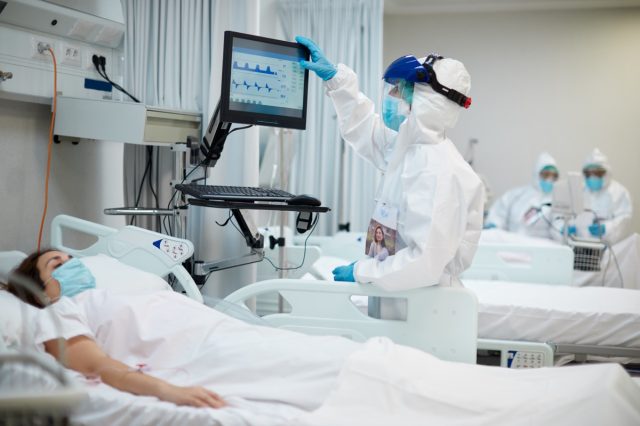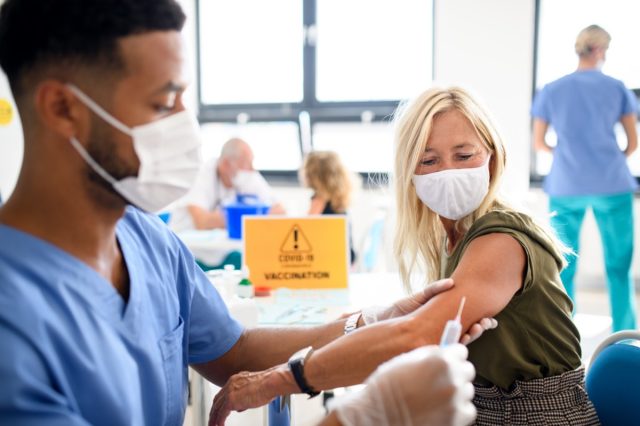A new COVID variant is here, but in a surprise twist, it’s another form of Omicron. This new one, called BA.2, is suspected to be 50% more contagious than the original, says virus expert Dr. John Campbell, though the research is still ongoing, and has been spotted in various states across the U.S. So how can you stay safe, and what does all this mean for your winter and spring? Read on for 5 life-saving pieces of advice from Dr. Campbell—and to ensure your health and the health of others, don’t miss these Sure Signs You’ve Already Had COVID.
In the United States, “there’s no question that the number of cases are going down, but I am expecting them to blip up…for a short period of time, at least. And that’s because the BA.2 variant will become predominant in the United States in the next few weeks, I believe. And that’s 50% more transmissible. So there will be an uptick for a short period of time. I don’t believe there’s more people gonna get sick or hospitalized or die. I think this Omicron—this BA.2 is an Omicron is the same as BA.1, but it is more contagious, 50% more contagious. So that could well cause an uptick in cases in the states. Sad to see that the number of deaths in the states are still so high. We do know there’s a lot of comorbidities, but we do need more explanation really from the US authorities on that.” As for “hospital admissions—we do see it going down slightly. But of course, with the BA.2, that could actually go up a little bit.” And it’s “higher than it’s ever been.”
RELATED: Virus Experts Warn “COVID Won’t Ever Go Away”

BA.2 is doubling every few days and “could predominate within a month. And if it’s happening in the UK, this is going to be happening in the United States and in Canada and everywhere. BA.2 Omicron is going to take over from BA.1 Omicron. So the same way Delta displaced Alpha the same way that Omicron displaced Delta now Omicron is displacing Omicron. And we are pretty sure it’s got the same level of pathogenicity. It’s just a bit more contagious. So that means we’re gonna get herd immunity all the quicker, but it does mean there’s gonna be pressure on hospitals as well, over a shorter period of time than we would’ve liked.”
RELATED: Forgetting This One Thing Can Mean You’ve Got Dementia

“With the BA.2, it’s gonna run through much quicker. So cases will still be high into February, but by the end of February, most people will have been exposed to BA.2 Omicron and cases should start going down fairly dramatically then by about March, I would expect.” The good news is “ost vaccinated of infections are mild, symptoms lasting over a short period of time than Delta, less severe cases” though “we are still worried about the vulnerable groups, because they are going to be exposed to Omicron, just the same as everyone else’s.”
RELATED: Alzheimer’s Symptoms Often Appear in This Order

As of Tuesday, an average of 2,400 Americans are dying from COVID each day. That’s higher than the peak of the country’s first surge in April 2020 (2,200 deaths per day). “Now, why the hospitalizations are so high in the United States?” he asks. “I mean, we know that there’s more comorbidities, an older demographic in the population, but not really so much more than the UK, although there is more comorbidities. We know that vaccination rates are somewhat lower in the states, but there’s got to be more to it than that. We really need more explanation than this from the CDC or somewhere as to why the death rate in the states has remained as high as it has on an ongoing basis has always been higher.”
RELATED: If You Live Here, Omicron is “Out of Control”

“Doubly vaccinated, less likely to report long COVID—now this is important. So compared with the unvaccinated people, when they’re infected, 41% less likelihood of developing long COVID at 12 weeks. Now the proviso here, well, clearly we can see that double vaccination is reducing the incidence of long COVID. I think that’s pretty clear from this large scale ONA data, but of course this data was collected in the time of Delta. So the Long COVIDs we’re getting now were collected in the original wave, the Alpha wave or the Delta wave. It does not doesn’t tell us what’s gonna happen in the Omicron wave. So it tells us what’s happened in the past. So we can say that double vaccination, if you’ve had Delta, for example, is giving a 41% protection against hospitalization. It doesn’t tell us about the level of protection against Omicron. Now I’m actually expecting less long COVID with Omicron, but we don’t know this yet that the data is not there. It could turn out that there’s more Long COVID. I really don’t think so because the infections are largely in the mucosal compartment….but until the data’s in, we don’t actually know for sure.”
RELATED: Odd COVID Symptoms Doctors are Seeing Now

Follow the public health fundamentals and help end this pandemic, no matter where you live—get vaccinated or boosted ASAP; if you live in an area with low vaccination rates, wear an N95 face mask, don’t travel, social distance, avoid large crowds, don’t go indoors with people you’re not sheltering with (especially in bars), practice good hand hygiene, and to protect your life and the lives of others, don’t visit any of these 35 Places You’re Most Likely to Catch COVID.